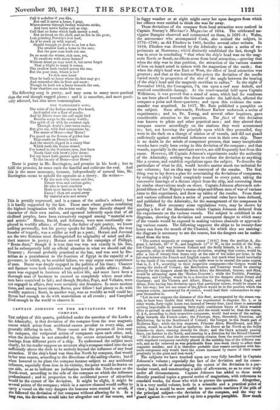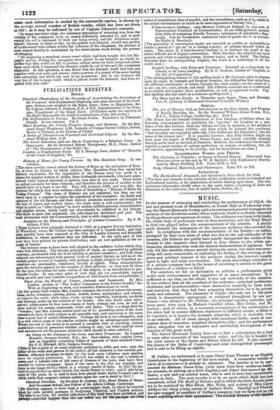CAPTAIN JOHNSON ON THE DEVIATIONS OF THE COMPASS.
THE subject of this quarto, published under the sanction of the Lords o the Admiralty, is that deviation of the compass from the true magnetic coarse which arises from accidental causes peculiar to every ship, and generally differing in each. These causes are the presence of iron near the compass, the reciprocal action of compasses upon each other, and, when the deviation is not attended to the errors occasioned by taking bearings from different parts of a ship. To understand the subject more clearly, let the reader suppose an accurate ship's compass raised into the air sufficiently above the deck to be entirely beyond the influence of any local attraction. If the ship's head was then due North by compass, that would be her true course, according to the directions of the sailing-charts; but if when lowered to its place the compass became subject to any accidental influence, especially from iron in its vicinity, the point would be drawn on one side, so as to indicate an inclination towards the North-east or the North-west, according to the side of the compass on which the influence predominated ; and in proportion to the accidental power of attraction would be the extent of the deviation. It might be slight, it might be several points of the compass; which in a narrow channel would suffice to carry a vessel on the very dangers the beacons were erected to avoid, if she followed the deviation of her compass without allowing for it. In a long run, the deviation would take her altogether out of her course, and
in foggy weather or at night might carry her upon dangers from which her officers were entitled to think she was far away.
These deviations of the compass from local attraction were noticed in Captain Sturmy's Mariner's Magazine of 1684. The celebrated na- vigator Dampier observed and commented on them, in 1691-3; Wales, the astronomer who accompanied Cook, also noticed the subject, in 1776-1780; as did Flinders in 1801, besides several other writers. In 1810, Flinders was directed by the Admiralty to make a series of ex- periments at Sheerness ; which distinctly established the fact, though he was in error in concluding " that when the ship's head was on the mag- netic North or South, no effects arose from local attraction,—proving that when the ship was in that position, the attraction of the various masses of iron on board acted in unison with the magnetism of the earth ; that when the ship's head was East or West, the effect of local attraction was greatest; and that at the intermediate points the deviation of the needle varied nearly in proportion of the sine of the angle between the bearing of the ship's head and the magnetic meridian to radius." In the night of November 1812, the Courag,eux, 74, ran upon a reef near Anholt, and received considerable damage. At the court-martial held upon Captain Wilkinson, it was proved that a stand of arms, which had for readiness in use been placed beneath the binnacle under the half-deck, affected the compass a point and three-quarters; and upon this evidence the com- mander was acquitted. In 1817, Mr. Bain published a pamphlet on the subject. Soon afterwards, Professor Barlow undertook a series of experiments ; and he, Dr. Young, and several other inquirers, gave considerable attention to the question. The fact of' this deviation was known to pilots and other practical men ; and they altered their compass course accordingly on the stations they were accustomed to; but, not knowing the principle upon which they proceeded, they were in the dark on a change of station or of vessels, and did not guard
sufficiently against accidental influences even in their own ship. here is no doubt in the minds of competent persons, that many inexplicable wrecks have really been owing to this deviation of the compass ; and that vessels, especially in the merchant service, are still frequently lost from this cause. However, till Captain Johnson's experiments under the authority of the Admiralty, nothing was done to reduce the deviation to anything like a system, and establish regulations upon the subject. To describe the particulars of what he did, would involve matter much too technical for our columns; but an idea may be conveyed of the results. The first thing was to lay down a plan for ascertaining the deviations of compasses, by swinging a ship's head completely round to every point, taking the successive bearings of a distant object from the ship, and correcting them by similar observations made on shore. Captain Johnson afterwards sub- jected fifteen of her Majesty's steam-ships and fifteen men of war of various rates to this experiment, and drew up tables of the results. From these and various collected facts a series of practical rules have been deduced, and published by the Admiralty, for the management of the compasses in the Navy. How necessary some regulations were, may be shown by quoting a few of the illustrations which Captain Johnson deduced from his experiments on the various vessels. The subject is exhibited in six diagrams, showing the deviation and consequent danger to which many of the vessels would be exposed in making various channels or approach- ing various coasts. The following supposes the ships to be twenty-four hours run from the month of the Channel, for which they are steering: the diagram is necessary to see the course, but the danger, can be under- stood from the text.
"The correct magnetic or compass course [18463 from the position A, dia- gram 1, latitude, 48° 0' N., and longitude 11 0' W, to the mouth of the Eng- lish Channel,. half way between Ushant and the Scilly. Islands, is E. I S.; con- sequently, ships in which there was no deviation, steering that course, would be, after a ran of twenty-four hours only at the rate of ten miles per hour, in the fair-way between the French and English coasts: but mark what would inevitably be the result if the vessels named in the table were to be steered the same coarse, that is, E. S., according to their respective compasses—the Gorgon would be among the rocks off Ushant; the Retribution and Vesuvius would be steering directly for the dangers about the Seven Isles; the Stromboli, Geyser, and Styx, would be advancing upon the 'Roches Donvres'; while the Terrible, Penelope, Sampson, and Cyclops, would be in a direction for the dangers about Jersey and Guernsey; and the Victoria and Albert, Blazer, Porcupine, Black Eagle, and Alban, from having less deviation upon that particular course, would be nearer to the fair-way; but not one vessel of the,fifteen would be in the position which the compass course, uncorrected for deviation, would lead their commanders to sup- pose themselves in. "Let us now suppose the distance of this fleet, accompanied by the steam-ves- sels, to have been double that which was represented in diagram No. 1, or in other words, forty-eight hours run instead of twenty-four, (and there is assuredly nothing improbable in assuming forty-eight continuous hours of thick weather often to prevail in our humid climate,) and the result would be, that the course, E. 4 S., according to their respective compasses, would lead some of the sailing- ships towards the French coast; the Penelope, Styx, Stromboli, Vesuvius, and Retribution, far to the Southward of Ushant; the Gorgon to the South part of Hodierna Bay; while the iron steamers, Princess Alice, Bloodhound, and Myr- midon, would be as far South as Qaiberon; the Dover as far North as the Scilly Islands—in short, running directly for them; and the Onyx actually passing them, yet farther to the North, and steering in a direction for the Bristol Channel.
"Be it observed, that the above reasoning obtains from the results ascertained with standard compasses carefully placed in the midship line of the different ves- sels, and as far removed as was practicable from iron-work likely to affect their magnetic needles; and it is therefore probable that vessels navigated with bin- nacle compasses only would have the errors increased by reason of their nearer proximity to the guns and iron-work."
The subjects we have touched upon are very fully handled in Captain Johnson's volume ; especially the fact of the deviation and its conse- quences, the mode of ascertaining the extent of the deviation in a par- ticular vessel, and constructing a table of allowances, so as to steer truly under all circumstances. Captain Johnson has added to these more directly practical topics a general notice of magnetism, with references to standard works, for those who wish to pursue the question. Altogether, it is a very useful volume, both in a scientific and a practical point of view ; but it would be more useful to mercantile mariners if the pith of the principal subject—the deviation of the compass, and the way to guard against it—were packed up into a popular pamphlet. How much
some such information is needed by the mercantile marine, is shown by the average annual number of British wrecks, which has been set down at. 547 ; as it may be indicated by one of Captain Johnson's remarks. " In many merchant-ships the necessary precaution of removing iron from the vicinity of the compasses is by no means sufficiently attended to, and in such vessels the evil is increased by their not being swung and the deviations ascer- tained; whereas in ships-of-war, by the system now adopted, should any portion of undiscovered iron remain within the influence of the compasses, the amount of error caused thereby is ascertained by the observations made during the process of swinging.
" On inspecting a merchant steam-vessel which had been bought into her Ma- jesty's service, finding the compasses were placed in one binnacle so closely to- gether that they could not fail to produce serious errors by their reciprocal action upon each other, I requested the binnacle might be cut in two and the compasses separated. In this operation, it was found that the binnacle itself had been put together with iron nails and screws; three-quarters of a pound of the same having been extracted, and which are now in my possession; and in one instance the very box of the compass itself, which is placed inside the binnacle, had been re- paired with iron nails."



























 Previous page
Previous page